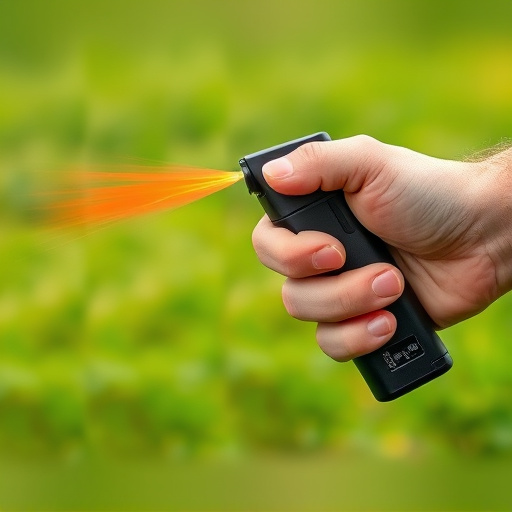Bear spray, a potent pepper spray designed for wildlife interactions, offers crucial protection against bear attacks. Effective when used correctly (aiming for face and eyes), it creates a temporary blindness and irritation barrier, allowing users to escape unharmed within 4-6 seconds. Its use should be a last resort after failing other de-escalation strategies, and safety measures like aiming for the eyes, maintaining distance, checking expiration dates, and seeking medical attention post-exposure are essential. Responsible deployment in bear country requires understanding local regulations and proper training.
“Bear spray has emerged as a crucial defense mechanism for outdoor enthusiasts navigating unpredictable wildlife territories. This article explores the multifaceted aspect of bear spray defense, delving into its composition and effectiveness as a deterrent. We guide you through recognizing attack signals, ensuring safe usage practices, and implementing post-exposure care to minimize complications. Learn when to deploy pepper spray safely, enhancing your survival skills in encounters with these majestic yet potentially dangerous creatures.”
- Understanding Bear Spray: Its Composition and Effectiveness
- When to Deploy Pepper Spray: Recognizing Attack Signals and Safe Usage Practices
- Safety Measures and Post-Exposure Care: Preventing Complications and Seeking Medical Attention if Necessary
Understanding Bear Spray: Its Composition and Effectiveness
Bear spray, also known as pepper spray designed for wildlife encounters, is a specialized defense tool used to deter and protect against bear attacks. Unlike conventional pepper spray, bear spray is formulated to be extra-potent and contain higher concentrations of capsaicin, the active ingredient responsible for the burning sensation. Its primary purpose is to create a temporary blindness and severe irritation in the bear’s eyes and respiratory system, allowing the user to escape unharmed.
When used safely and appropriately, bear spray can be an effective deterrent during potential encounters with bears in their natural habitats. It’s crucial to understand the recommended usage guidelines and timing. Users should aim for the bear’s face and eyes when spraying, ensuring a direct hit. The spray’s effectiveness typically lasts for around 4-6 seconds, providing a brief window to create distance from the animal. Proper training and knowledge of local regulations regarding bear spray use are essential to ensure safety during outdoor activities in bear country.
When to Deploy Pepper Spray: Recognizing Attack Signals and Safe Usage Practices
When faced with an animal attack, knowing when to deploy pepper spray can be a life-saving skill. Bear spray, designed specifically for use against bears, is highly effective in deterring and disabling larger wildlife. However, it should only be used as a last resort when all other escape or de-escalation strategies have failed. Recognizing the subtle attack signals from the animal is crucial; these might include lunging motions, snorting, huffing, or growling. The spray creates a barrier of capsaicin, the active ingredient causing intense irritation and disorientation in the target animal, giving you valuable time to retreat to safety.
Safe usage practices are paramount when carrying bear spray. Ensure it is readily accessible, but avoid pointing it at people or pets unless an attack is imminent. Practice aiming techniques regularly to guarantee accurate deployment under stress. Keep your spray charged and check its expiration date periodically. Remember, the key to successful use of pepper spray is recognizing the danger early and responding swiftly yet responsibly.
Safety Measures and Post-Exposure Care: Preventing Complications and Seeking Medical Attention if Necessary
When using bear spray as a defense mechanism, it’s crucial to understand the safety measures and post-exposure care required to prevent complications. Always remember to aim for the eyes and face of the attacking animal, keeping a safe distance while spraying. Ensure the wind is blowing away from you to avoid inhalation of the spray by yourself or others nearby. After an exposure, quickly move to a secure location and thoroughly wash the affected areas with soap and water.
Seeking medical attention is essential, even if initial symptoms seem mild. Bear spray can cause various reactions, including eye irritation, skin burns, respiratory distress, and allergic responses. A healthcare professional should evaluate any persistent or severe symptoms to prevent potential long-term health issues. Remember, prevention is key; carry bear spray responsibly, stay aware of your surroundings in bear country, and follow local guidelines for safe usage and storage.
Bear spray is a valuable tool for defending against animal attacks, but its effective usage depends on understanding its composition, recognizing attack signals, and adhering to safe deployment practices. By knowing when to use pepper spray responsibly and taking necessary safety measures post-exposure, individuals can minimize risks and ensure their well-being in potential encounters with bears or other wild animals. Remember, proper education and preparation are key to navigating these situations safely.
